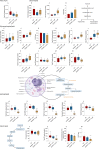Replacement Flame-Retardant 2-Ethylhexyldiphenyl Phosphate (EHDPP) Disrupts Hepatic Lipidome: Evidence from Human 3D Hepatospheroid Cell Culture
- PMID: 36693630
- PMCID: PMC9910051
- DOI: 10.1021/acs.est.2c03998
Replacement Flame-Retardant 2-Ethylhexyldiphenyl Phosphate (EHDPP) Disrupts Hepatic Lipidome: Evidence from Human 3D Hepatospheroid Cell Culture
Abstract
The present study aims to evaluate the effects of repeated exposure to 2-ethylhexyldiphenyl phosphate (EHDPP) on human liver cells. In vitro three-dimensional (3D) hepatospheroid cell culture was utilized to explore the potential mechanisms of EHDPP-mediated metabolic disruption through morphological, transcriptional, and biochemical assays. Lipidomics analysis was performed on the individual hepatospheroids to investigate the effects on intracellular lipid profiles, followed by hepatospheroid morphology, growth, functional parameters, and cytotoxicity evaluation. The possible mechanisms were delineated using the gene-level analysis by assessing the expression of key genes encoding for hepatic lipid metabolism. We revealed that exposure to EHDPP at 1 and 10 μM for 7 days alters the lipid profile of human 3D hepatospheroids. Dysregulation in several lipid classes, including sterol lipids (cholesterol esters), sphingolipids (dihydroceramide, hexosylceramide, ceramide, sphingomyelin), glycerolipids (triglycerides), glycerophospholipids, and fatty acyls, was noted along with alteration in genes including ACAT1, ACAT2, CYP27A1, ABCA1, GPAT2, PNPLA2, PGC1α, and Nrf2. Our study brings a novel insight into the metabolic disrupting effects of EHDPP and demonstrates the utility of hepatospheroids as an in vitro cell culture model complemented with omics technology (e.g., lipidomics) for mechanistic toxicity studies.
Keywords: 3D spheroids; flame retardants; lipidomics; metabolic disrupting chemicals; repeat dose toxicity.
Conflict of interest statement
The authors declare no competing financial interest.
Figures







References
-
- Xu F.; Tay J. H.; Covaci A.; Padilla-Sánchez J. A.; Papadopoulou E.; Haug L. S.; Neels H.; Sellström U.; de Wit C. A. Assessment of Dietary Exposure to Organohalogen Contaminants, Legacy and Emerging Flame Retardants in a Norwegian Cohort. Environ. Int. 2017, 102, 236–243. 10.1016/j.envint.2017.03.009. - DOI - PubMed
-
- Zhao L.; Jian K.; Su H.; Zhang Y.; Li J.; Letcher R. J.; Su G. Organophosphate Esters (OPEs)in Chinese Foodstuffs: Dietary Intake Estimation via a Market Basket Method, and Suspect Screening Using High-Resolution Mass Spectrometry. Environ. Int. 2019, 128, 343–352. 10.1016/j.envint.2019.04.055. - DOI - PubMed
Publication types
MeSH terms
Substances
LinkOut - more resources
Full Text Sources
Miscellaneous

